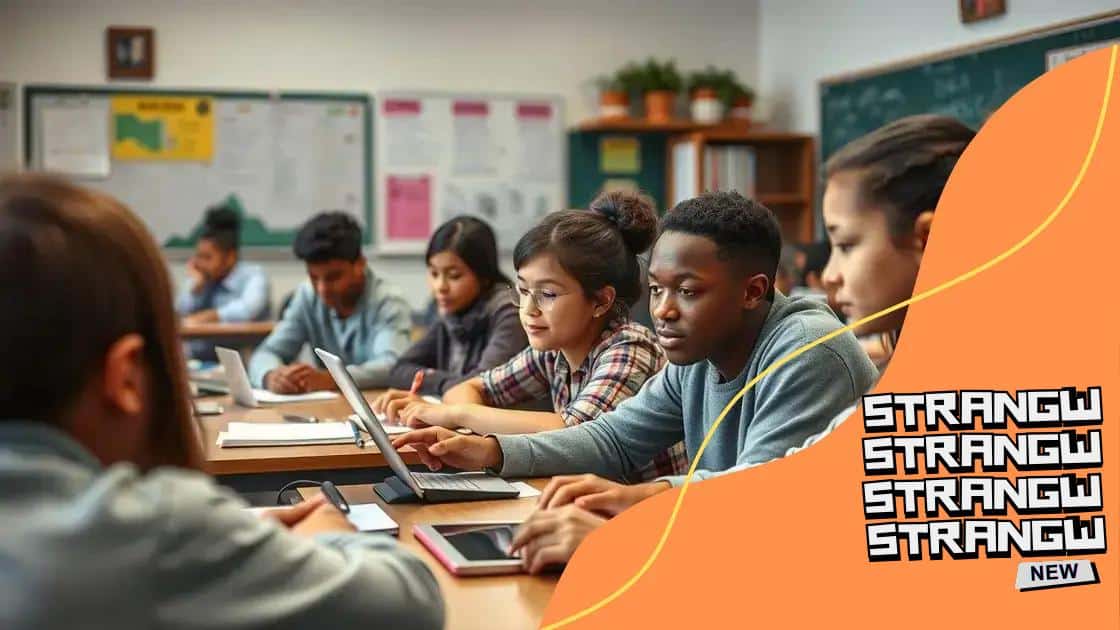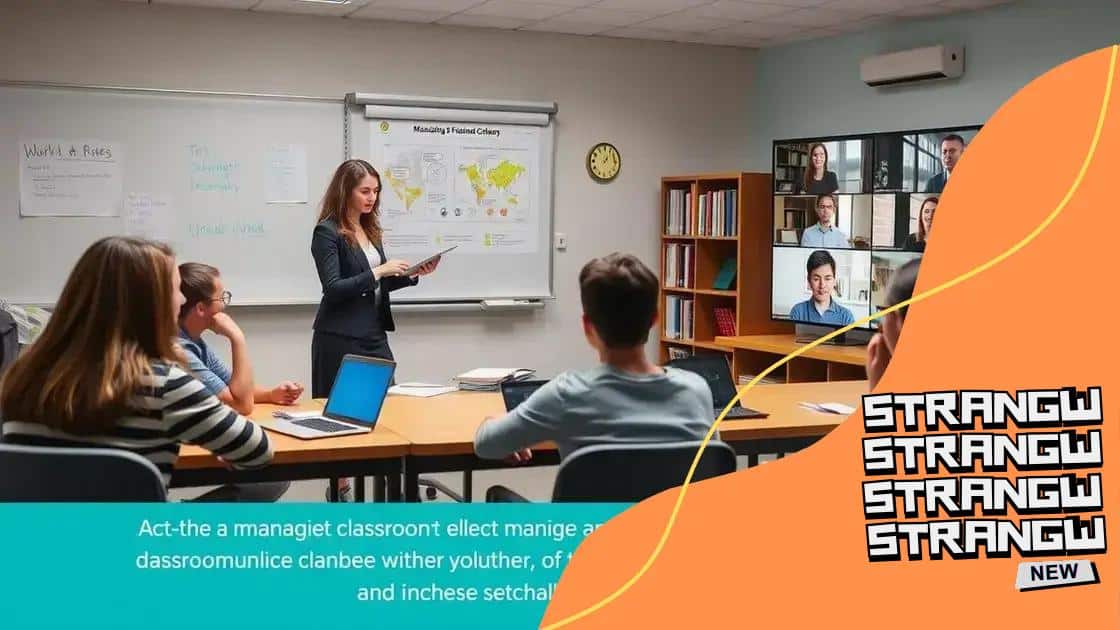Hybrid learning models in education: a fresh approach

Hybrid learning models combine in-person and online education, offering flexibility and personalized learning, while integrating technology and focusing on student engagement and well-being.
Hybrid learning models in education are changing the way we think about teaching and learning. Imagine a space where online and face-to-face interactions blend seamlessly, making education more accessible and engaging for everyone.
Understanding hybrid learning models
Understanding hybrid learning models is essential in today’s educational landscape. This approach combines traditional classroom methods with online learning, allowing students to engage with materials in various ways.
What are hybrid learning models?
Hybrid learning models integrate both in-person and digital learning experiences. This means students might attend physical classes some days while engaging in online coursework on others. This flexibility can meet diverse learning needs.
Key components of hybrid learning
- Flexibility: Students can choose when and where to learn.
- Engagement: Interactive technologies keep students involved.
- Personalization: Learning paths can be tailored to individual needs.
- Accessibility: Education is more reachable for various learners.
In hybrid learning, technology plays a pivotal role. Tools such as video conferencing and learning management systems connect teachers and students seamlessly. This connection enhances communication and supports collaborative work. For instance, teachers can use online forums to discuss assignments with students outside of class hours.
Another significant aspect is the ability to cater to different learning styles. Students who excel in visual learning can engage with videos and infographics. Meanwhile, those who prefer auditory learning benefit from podcasts and lectures. This varied approach not only maintains interest but also promotes better understanding.
Benefits of hybrid learning models
Implementing hybrid learning models offers numerous advantages. For one, it prepares students for a digital world. By utilizing technology, they become more adept at navigating online environments. Additionally, it fosters self-directed learning. Students learn to manage their time and responsibilities effectively.
- Enhanced collaboration: Students can work together online across locations.
- Increased motivation: Choices in learning can boost enthusiasm.
- Effective resource use: Schools can optimize physical and digital resources.
Moreover, hybrid models can address challenges like large class sizes. By incorporating online components, educators can focus on smaller groups during in-person sessions. This structure encourages more interaction and personalized feedback.
Benefits of hybrid learning in education
The benefits of hybrid learning in education are becoming increasingly clear. This model combines the best of both worlds—traditional in-person learning and online education—creating an enriched experience for students.
Increased Flexibility
Hybrid learning allows for greater flexibility in scheduling. Students can choose when and where they learn, which can lead to better time management and an improved balance between schoolwork and personal life.
Enhanced Engagement
With the integration of technology, students often feel more engaged. Online platforms provide interactive tools and resources that make learning more dynamic. This engagement keeps students motivated and interested in the material.
- Interactive resources: Games, videos, and forums enhance learning.
- Personalized learning: Students can learn at their own pace.
- Variety in teaching styles: Different formats cater to various learning preferences.
Moreover, hybrid models can promote collaboration among students. Using online platforms, learners can easily connect with each other, even if they are not physically together. This collaboration helps develop communication skills and fosters teamwork in assignments and projects.
Another significant advantage is the improved accessibility to resources. Students have access to a wider range of materials and tools online, which can support diverse learning needs. For instance, students may access recorded lectures or supplementary videos whenever they need help with a topic.
Preparation for the Future
With the job market increasingly leaning towards digital skills, hybrid learning models prepare students for their future careers. They become familiar with technology and gain vital skills needed in the workforce.
- Critical thinking: Students enhance problem-solving skills through varied learning scenarios.
- Technological literacy: Comfort with tech tools is crucial in today’s world.
- Self-directed learning: Students learn how to take charge of their education.
Additionally, hybrid learning can address challenges such as large class sizes. By incorporating online components, teachers can focus on smaller groups, allowing for more personalized attention. This setup encourages students to participate more actively and receive feedback tailored to their individual needs.
Challenges of implementing hybrid learning

Implementing hybrid learning comes with unique challenges that educators and institutions must navigate carefully. While this approach offers a blend of in-person and online learning, it requires thoughtful planning and execution.
Technical Issues
One of the primary challenges is ensuring reliable technology. Students and teachers need access to devices and internet connectivity at all times. Without stable resources, the learning experience can suffer significantly, leading to frustration and disengagement.
Training for Educators
Teachers may also require training to adapt to hybrid models effectively. Not all educators are comfortable with technology or online teaching strategies. Providing adequate professional development is crucial so that teachers can facilitate engaging lessons online and offline.
- Understand new tools: Educators must learn various platforms and applications.
- Engage students: Finding ways to keep students motivated across different formats is vital.
- Balance activities: Teachers need to design lessons that fit both online and in-class environments.
Another significant concern is the uneven level of student preparedness. Some students thrive in online settings, while others may struggle with self-regulation and time management. Schools need to recognize these differences and provide support to ensure all students can succeed in a hybrid environment.
Equity is another crucial factor. Not every student has the same access to technology or a conducive learning environment at home. Addressing these disparities is essential for creating an inclusive hybrid learning atmosphere. For example, providing loaner devices or internet hotspots can help level the playing field.
Classroom Management
Another challenge is managing hybrid classrooms effectively. Teachers must engage both in-person and online students simultaneously. This can create a divide and make it hard for teachers to give equal attention to everyone.
- Maintain engagement: Finding ways to interact with both groups is essential.
- Encourage participation: Teachers need strategies to motivate all students to contribute.
- Adapt assessments: Testing and evaluation methods must be suitable for both environments.
Additionally, communication between students, parents, and teachers can become complex in a hybrid setting. Clear channels must be established to ensure everyone is informed about expectations and progress. Regular updates can help build this communication, fostering a stronger community of learning.
Best practices for effective hybrid education
To ensure successful hybrid education, it’s crucial to follow best practices that enhance the learning experience for all students. These strategies combine in-person instruction with online resources effectively.
Establish Clear Communication
Clear communication is vital for the success of hybrid education. Teachers should regularly update students and parents about schedules, assignments, and expectations. Using platforms like email, messaging apps, and learning management systems helps everyone stay informed and engaged.
Utilize Technology Effectively
Integrating technology is essential in a hybrid model. Teachers should select appropriate online tools that support their teaching methods. Tools such as video conferencing software, collaborative document editors, and educational apps can keep students connected and engaged.
- Engage in interactive lessons: Use polls, quizzes, and discussions to involve students.
- Provide diverse materials: Incorporate videos, articles, and podcasts to cater to different learning styles.
- Encourage collaboration: Facilitate group projects that blend online and in-class participation.
Another effective practice is to set up a flexible schedule. This allows students to balance their time between online learning and in-person classes. For example, dedicating specific days for physical attendance and others for virtual participation can help maintain structure while providing flexibility.
Focus on Student Engagement
Keeping students engaged in a hybrid environment can be challenging but is vital. Incorporate activities that capture their interests, such as gamifying lessons or using real-life projects. In addition, provide regular feedback to motivate students and recognize their achievements.
- Encourage participation: Ask open-ended questions that prompt discussion among peers.
- Adopt a growth mindset: Foster resilience by encouraging students to embrace challenges.
- Host virtual office hours: Allow students to seek help and discuss topics outside of regular class times.
Utilizing assessment strategies that cater to both learning environments can enhance understanding. Provide varied assessments like online quizzes, video presentations, and group discussions. This variety helps address different strengths and keeps students engaged.
Continuous Professional Development
Finally, investing in continuous professional development for educators is essential. Training on new technologies and teaching strategies helps teachers adapt to hybrid formats effectively. Workshops, webinars, and peer collaboration can enhance their skills and boost confidence in delivering quality education.
Future trends in hybrid learning models
The future of hybrid learning models is bright and full of exciting possibilities. As education continues to evolve, so do the strategies and technologies that support diverse learning experiences.
Increased Use of Artificial Intelligence
One trend is the integration of artificial intelligence (AI) into hybrid learning environments. AI can personalize learning experiences by adapting content to meet the needs of individual students. For example, AI programs can analyze a student’s strengths and weaknesses to suggest tailored resources and tasks.
Enhanced Virtual Reality Experiences
Virtual reality (VR) is another technology set to influence hybrid learning significantly. VR can create immersive learning experiences, allowing students to explore complex topics in a more engaging way. Imagine students virtually visiting historical sites or practicing science experiments in a simulated environment.
- Immersive simulations: Engaging students through hands-on experiences.
- Real-Time Collaboration: Allowing students to work together in virtual settings.
- Skill Development: Preparing students for real-world applications.
Furthermore, as the global workforce evolves, skills like digital literacy and critical thinking will become paramount. Hybrid learners will need to develop these skills through flexible and varied educational approaches. Schools are likely to place a stronger emphasis on fostering creativity and problem-solving abilities in their curriculums.
Growing Emphasis on Student Well-Being
Another trend is the increasing focus on student well-being in hybrid learning models. Educators are recognizing that mental health support is essential for successful learning. This might include regular check-ins, access to counseling services, and promoting a balanced approach to academic and personal life.
- Mindfulness Practices: Encouraging relaxation and focus through mindfulness exercises.
- Flexible Scheduling: Allowing students to manage their time better.
- Community Building: Fostering connections among students to create supportive networks.
Additionally, as hybrid learning matures, institutions will likely invest in training educators to effectively use new technologies and methodologies. Professional development opportunities will prepare teachers to embrace innovations confidently, ensuring they can deliver quality education in a hybrid format.
In summary, hybrid learning models are transforming education by combining traditional and digital methods. These models provide flexibility, engagement, and personalized learning experiences. As we look to the future, trends such as artificial intelligence, virtual reality, and a focus on student well-being will further enhance these educational approaches. By embracing these changes, schools can better prepare students for a successful future in a rapidly evolving world.
FAQ – Frequently Asked Questions about Hybrid Learning Models
What are hybrid learning models?
Hybrid learning models combine traditional in-person classes with online education, providing flexibility and engagement for students.
How does technology play a role in hybrid learning?
Technology enhances hybrid learning by providing tools like video conferencing, collaborative platforms, and educational apps that connect students and educators.
What are some benefits of hybrid learning?
Benefits include increased flexibility, personalized learning experiences, and the ability to develop both digital literacy and critical thinking skills.
What challenges might schools face when implementing hybrid learning?
Challenges include ensuring reliable technology access, training teachers effectively, and addressing disparities in student preparedness and support.





